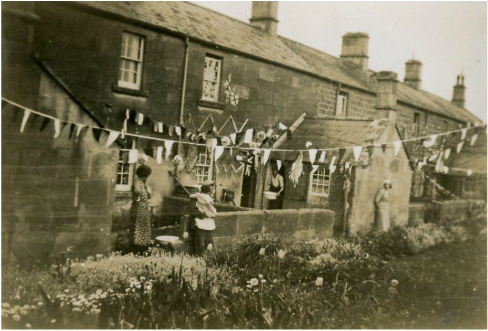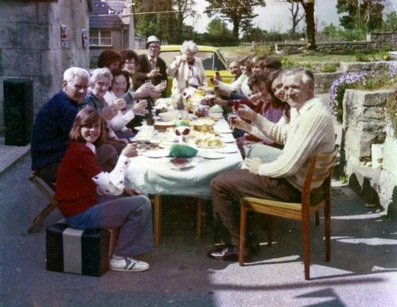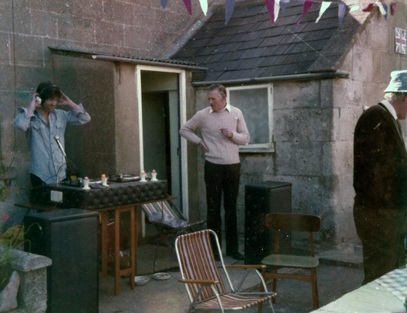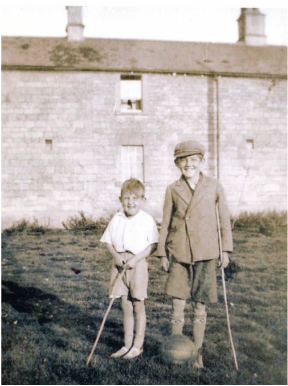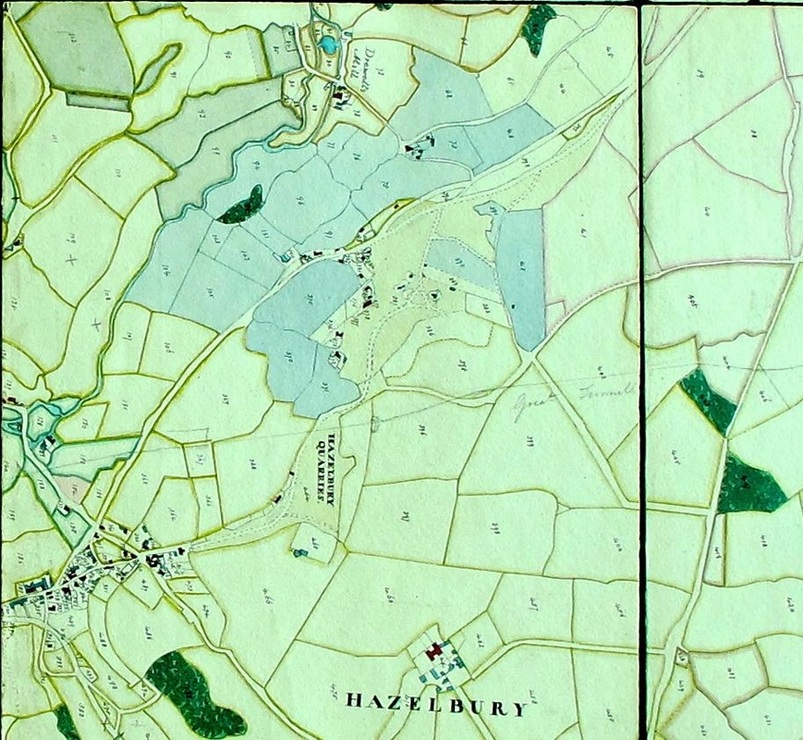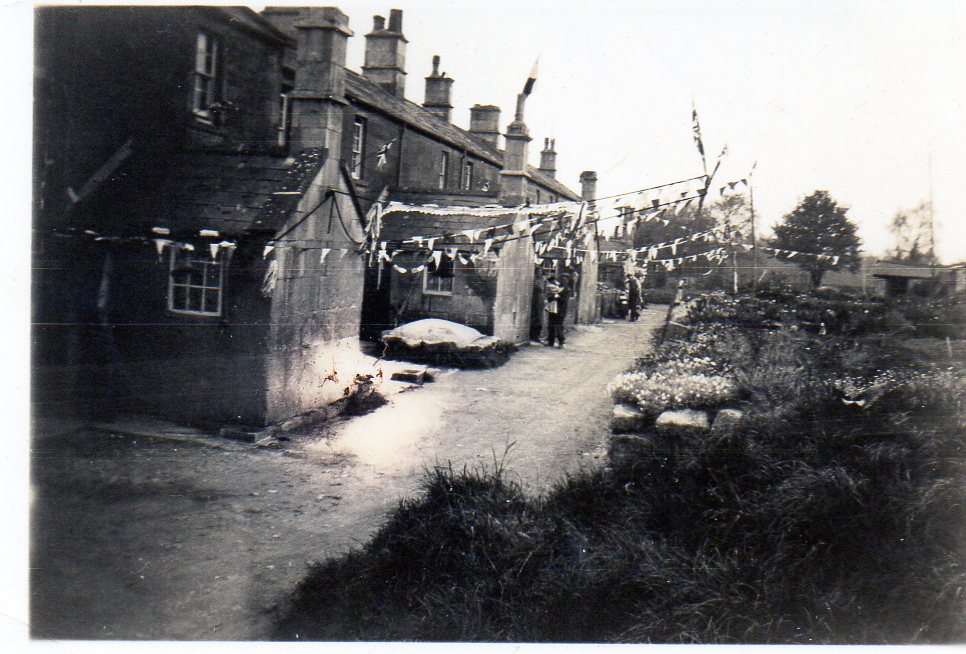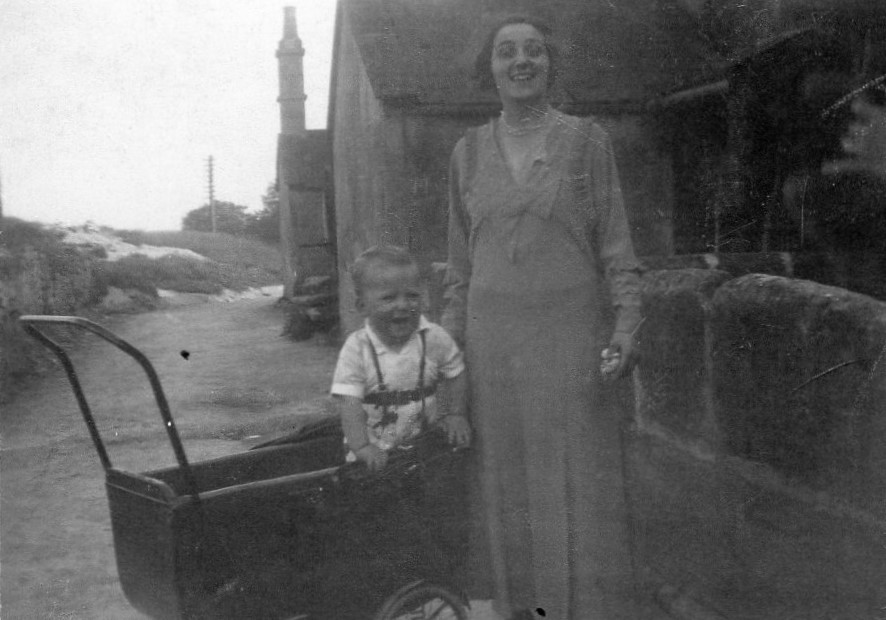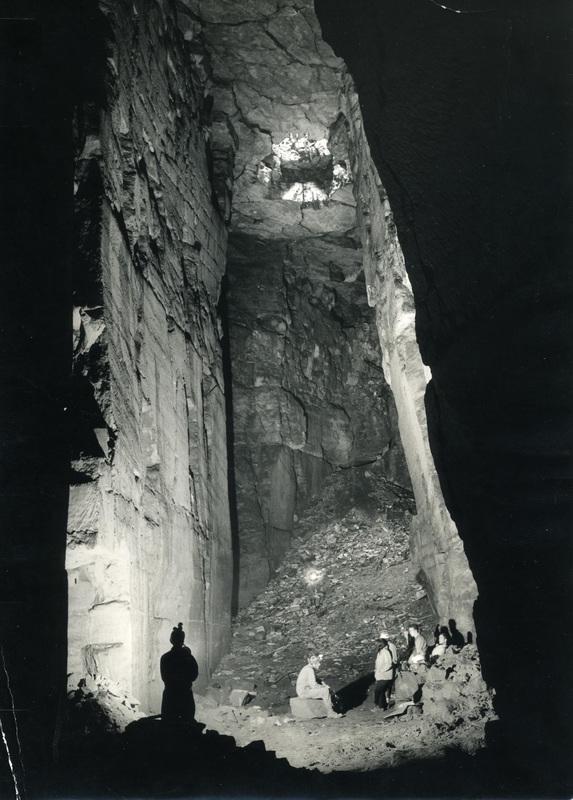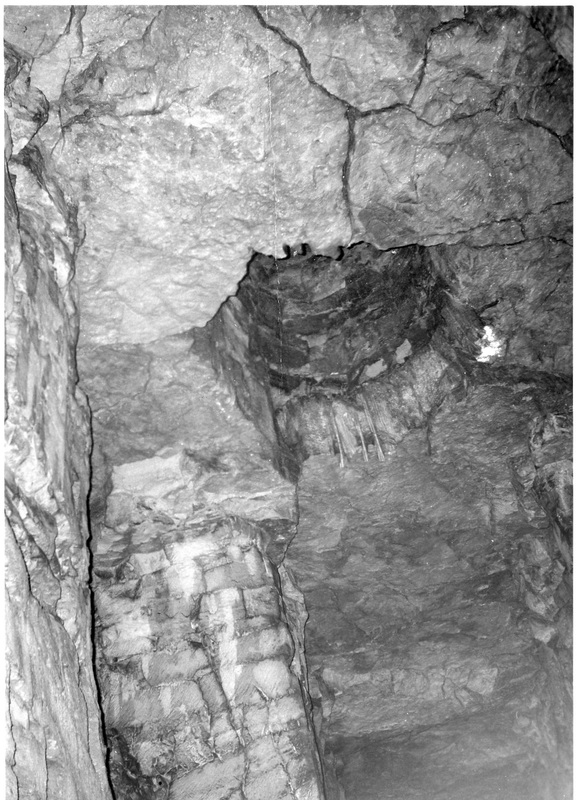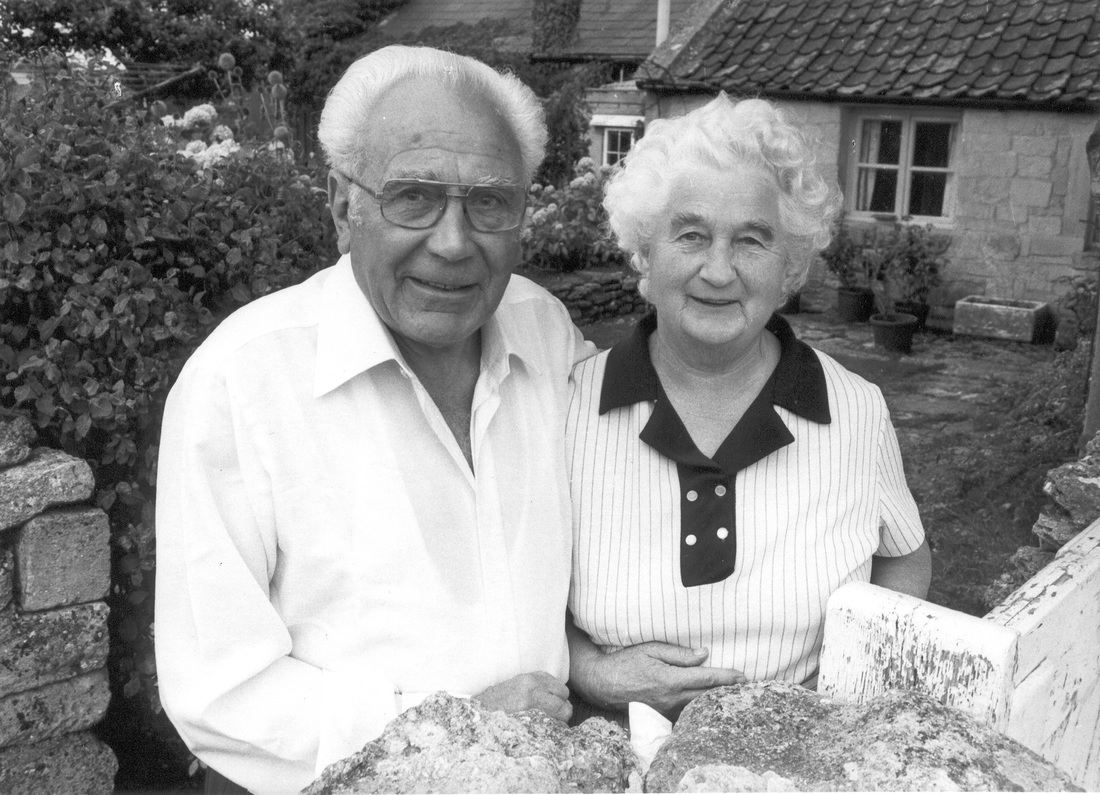|
Boxfields Cottages Story
Carolyn Pote July 2016 Photos and memories courtesy of past and present residents of the row of cottages at Boxfields. This is an account with a mystery attached: When was the row of cottages at Boxfields built, and what was their original use? Documentation in the 1800s for buildings other than those of note is scarce, so some detective work was required! Right: Bunting out for VE Day (Victory in Europe) in 1945 |
Boxfields is a micro community and the layout of the area has always lent itself to a very social environment. Everyone passes to and fro from the allotments to the houses and, in previous days, to the outside lavatories! The residents have seen many occasions over the years, and know how to celebrate.
A street party for the Queen’s Silver Jubilee in 1977. In the photo above left, from front left, moving round the table: Wendy Hall, Frank Milanowski, Maud Holder, Gladys Neely, Paul Neely, Ivy Clutterbuck, Joseph Neely, Nancy Milanowski, unknown, Sylvia Lucas, 2 unknown, Jane Hall, Rita Hall, Gladys Spendlowe, and Mervyn Clutterbuck.
|
Boxfields lies at the furthest reaches of Box Parish and feels affiliated to numerous communities. In World War 2 it was known as Hawthorn, an extension both in one direction of Box Hill and in the other of Rudloe, and has a Corsham postal address.
The area originally consisting of an agricultural field called Box Field, together with a couple of properties, Tunnel Inn and Berry Cottages. Later a single row of houses, known as Boxfields, were built. Subsequently the area grew exponentially when the prefabs of World War 2 were erected and their story is recalled at Boxfields Estate.[1] After the war, these properties were demolished and the area shrank just as dramatically as it had evolved. Left: John Lucas playing in Boxfield in about 1937. The small and sparse windows of the houses, common of their era, can be seen clearly behind. |
This article focuses on the row of (originally) nine cottages. The local Tithe map of 1840 shows Boxfield, Tunnel Inn and Berry Cottages. There is no row of cottages on the eastern side of the field. By 1851 Box Field Quarries appears as a set of houses on the census, and by 1871 they are known simply as Boxfields. An early version of the Ordinance Survey maps from 1859 also details them.
Origin of the Cottages
It is surprising to find that the row of houses was constructed after or during the final days of work on Box Tunnel and not to house workers for the duration on the Tunnel construction. The Tunnel itself runs just tens of metres from the end of the row (and quite a few metres below!), and there were access shafts situated nearby. Tunnel Inn certainly served as a popular watering hole for many of the navvies working on the Tunnel ! So it would seem logical for the cottages to have been built as accommodation for the workers. Perhaps workers did live there, but in the temporary huts that commonly served as the basic accommodation for them.
The houses perhaps then sprung up when the tunnel workers moved on, simply for agricultural workers and landowners locally. Though a logical supposition could also be that the properties were constructed for those linked to the Quarries. Box Hill is a veritable maze of mines, quarries and natural wonders, the Cathedral in fact sits right below Boxfields, and a well, now inaccessible, sits underneath cottage no 3. The residents are treated to flying displays from the bats that live in the Cathedral and use the shaft for access, and to plumes of mist rising from the shaft on a cold morning.
It is surprising to find that the row of houses was constructed after or during the final days of work on Box Tunnel and not to house workers for the duration on the Tunnel construction. The Tunnel itself runs just tens of metres from the end of the row (and quite a few metres below!), and there were access shafts situated nearby. Tunnel Inn certainly served as a popular watering hole for many of the navvies working on the Tunnel ! So it would seem logical for the cottages to have been built as accommodation for the workers. Perhaps workers did live there, but in the temporary huts that commonly served as the basic accommodation for them.
The houses perhaps then sprung up when the tunnel workers moved on, simply for agricultural workers and landowners locally. Though a logical supposition could also be that the properties were constructed for those linked to the Quarries. Box Hill is a veritable maze of mines, quarries and natural wonders, the Cathedral in fact sits right below Boxfields, and a well, now inaccessible, sits underneath cottage no 3. The residents are treated to flying displays from the bats that live in the Cathedral and use the shaft for access, and to plumes of mist rising from the shaft on a cold morning.
Below left: Photo from the VE day celebrations, taken from the land opposite number 1, shows the low, pale, concrete mound that covered the well outside number 3. (Courtesy Maurice and Lorraine Holder).
What is now the garden of cottage number 1 was listed as part of the mines in an Inland Revenue map from 1910. Until the 1960s when the Quarry shut, it sited huge pile of stones from the quarrying activity. These were known as the Tumps and many locals remember playing there as children. Maurice Holder remembers the Home Guard using the Tumps as a vantage point during the war. In the background of the photo above right are Maud Holder with her son Tony outside number 4 Boxfields. You can see part of the area known as the Tumps. The chimney of the washroom of number 1 stands proudly, though now removed (courtesy Maurice and Lorraine Holder).
The Cathedral, left, and the well, right, taken from below, which lies underneath Boxfields (Images courtesy of Bob Hancock).
It is believed that some of the properties were originally used as stables. Mervyn Clutterbuck, who at different times lived in number 1 and latterly 5 remembers finding some evidence of number 5 having been used as stables when he moved in and started home improvements many years ago. Maurice and Lorraine Holder, who lived at number 3 also found evidence of such. When they gutted the house to modernise it they found remaining elements of the stable roof. There was a big arched roof structure upstairs against the wall of number 2, which gave an indication of the old roofline, and the timber was quite weak in the first floor, suggesting a quick original conversion from a single storey building.
Gladys Neely (via her brother Brian Palmer), remembers evidence of the very basic structure of the original row. Gladys, who lived at number 2 then number 7, describes that, when renovating number 7, the loft structure was so basic you could see from number 1 through to number 9 ! Gladys remembers being told that numbers 1 and 2 were the main building(s) for the ostlers [stablemen, especially at an inn], with the stables located from number 3 onward. She also remembers the lean-to on the end wall of number 1 which she believed to be a store for dynamite used in the Tunnel. There was certainly a lean-to there, but its contents, or indeed its existence at the time the tunnel was build, will probably never be fully known.
Gladys Neely (via her brother Brian Palmer), remembers evidence of the very basic structure of the original row. Gladys, who lived at number 2 then number 7, describes that, when renovating number 7, the loft structure was so basic you could see from number 1 through to number 9 ! Gladys remembers being told that numbers 1 and 2 were the main building(s) for the ostlers [stablemen, especially at an inn], with the stables located from number 3 onward. She also remembers the lean-to on the end wall of number 1 which she believed to be a store for dynamite used in the Tunnel. There was certainly a lean-to there, but its contents, or indeed its existence at the time the tunnel was build, will probably never be fully known.
Further facts point towards number 3 though to 5 being built either separately or for a different use to the other properties. The censuses from 1851 and 1861 detail three and five families only. By 1871 ten families resided on the row and this higher number continues from then on. Perhaps this was when the middle three properties were converted from stables to residential properties.
It is also apparent that, though the stone work seems to be of the same era, the front and dividing walls of numbers 3 to 5 have a single-skin stone, 5 inches deep (as confirmed by Maurice Holder and an unfortunate incident with a drill !), while numbers 1, 2, and 6 to 9 are of stone, approximately 1½ – 2 foot deep. The rear wall facing the field is of thick stone the full length of the row.
So we can surmise that perhaps there were two sets of houses at either end of the row, with stables in-between. It is easy to imagine a continuous wall running from 1 to 9, with stable frontage and dividing walls for numbers 3 to 5.
Interestingly, it is also debated as to whether numbers 1 and 2, which have an equal roofline, higher than all others in the row, used to be the master property, and was later split into two, only to be converted back to one property. We will probably never know!
It is also apparent that, though the stone work seems to be of the same era, the front and dividing walls of numbers 3 to 5 have a single-skin stone, 5 inches deep (as confirmed by Maurice Holder and an unfortunate incident with a drill !), while numbers 1, 2, and 6 to 9 are of stone, approximately 1½ – 2 foot deep. The rear wall facing the field is of thick stone the full length of the row.
So we can surmise that perhaps there were two sets of houses at either end of the row, with stables in-between. It is easy to imagine a continuous wall running from 1 to 9, with stable frontage and dividing walls for numbers 3 to 5.
Interestingly, it is also debated as to whether numbers 1 and 2, which have an equal roofline, higher than all others in the row, used to be the master property, and was later split into two, only to be converted back to one property. We will probably never know!
Residents in the Area
We can find out more through the families who lived and owned the houses in the row. The census shows a mix of vocations, both quarry related and agricultural, and a few long-standing family names.
We can find out more through the families who lived and owned the houses in the row. The census shows a mix of vocations, both quarry related and agricultural, and a few long-standing family names.
Neate Family
Boxfield itself and the row of houses was owned originally by the Neate family who also owned Berry Cottages, Tunnel Inn, Grove Farm and Hillcrest (built by Fred Neate himself). Much of the land that the Neates owned was bought from the Northey estate. Within the Boxfield area, previous to the Neate ownership, Box Field and Tunnel Inn were owned by William Wiltshire, Esq, who died in 1845. This was listed in the 1840 Tithe apportionment map and William Wiltshire also owned the Rising Sun Inn at this time!
The first record of the Neate family in Boxfields is John Neate (b 1781), who was the publican at Tunnel Inn in 1841. He is also listed in the Tithe apportionment of 1840 as living in a cottage in Boxfields.
A different John Neate (b 1830), a stone miner, was listed in the 1871 and 1881 censuses as living at Box Quarries, as the Boxfields row was originally called. They had many children, the third son being Frederick George Neate (b 1880), known as Fred, an individual well-known in the Boxfields and Box Hill area. From the 1891 through to the 1911 censuses, John and Mary Neate were living at Berry House (Berry Cottages as it is now called) but by 1901 their third son, Fred, was listed there as a stone quarryman, and in 1911 as a freestone sawyer. Fred used his skills to build Hillcrest in which he lived until he died in 1960.
Maureen Nixon, who lived in the Boxfields prefabs, remembers a Superintendent Neate living at number 1 Berry Cottages, known as Berry House at the time, in the 1940s and 1950s. The dynamic changed however as members of the family moved away, including an emigration to Australia, and Fred sold Boxfields to its tenants in the 1960s. To this day however, the southern half of Box Field is still proudly owned by the Neate family.
Boxfield itself and the row of houses was owned originally by the Neate family who also owned Berry Cottages, Tunnel Inn, Grove Farm and Hillcrest (built by Fred Neate himself). Much of the land that the Neates owned was bought from the Northey estate. Within the Boxfield area, previous to the Neate ownership, Box Field and Tunnel Inn were owned by William Wiltshire, Esq, who died in 1845. This was listed in the 1840 Tithe apportionment map and William Wiltshire also owned the Rising Sun Inn at this time!
The first record of the Neate family in Boxfields is John Neate (b 1781), who was the publican at Tunnel Inn in 1841. He is also listed in the Tithe apportionment of 1840 as living in a cottage in Boxfields.
A different John Neate (b 1830), a stone miner, was listed in the 1871 and 1881 censuses as living at Box Quarries, as the Boxfields row was originally called. They had many children, the third son being Frederick George Neate (b 1880), known as Fred, an individual well-known in the Boxfields and Box Hill area. From the 1891 through to the 1911 censuses, John and Mary Neate were living at Berry House (Berry Cottages as it is now called) but by 1901 their third son, Fred, was listed there as a stone quarryman, and in 1911 as a freestone sawyer. Fred used his skills to build Hillcrest in which he lived until he died in 1960.
Maureen Nixon, who lived in the Boxfields prefabs, remembers a Superintendent Neate living at number 1 Berry Cottages, known as Berry House at the time, in the 1940s and 1950s. The dynamic changed however as members of the family moved away, including an emigration to Australia, and Fred sold Boxfields to its tenants in the 1960s. To this day however, the southern half of Box Field is still proudly owned by the Neate family.
Pinker Family
The longest residing family in the row is the Pinker family, present since the 1851 census. The Pinkers came to Box in the early 1800s from Christian Malford. They seem to be related to a lot of local families, including the Oatleys, through Rhoda Ann Oatley. The Pinkers remained present throughout the history of Boxfields, working mainly as stonemasons, although latterly there was also a blacksmith and a gardener-grocer (semi illegible in the records) within the family. William Pinker born about 1920 was a mason journeyman (a mason who normally started as an apprentice and progressed to an experienced artisan in his trade).
Richard Pinker, remembers his grandfather, Frederick Pinker (son of William Pinker), who lived most of his married life in Boxfields. His grandfather, one of a twin, was born in Boxfields and he went on to be a coachman, finally returning to Tunnel Inn on his retirement in the 1930s. He and Richard’s father, Aubrey, knew Fred Neate well. In the 1940-50s another Pinker, Uncle Arthur, a cousin, lived in a bungalow in the quarry behind Berry cottages with access via The Gullet.
The longest residing family in the row is the Pinker family, present since the 1851 census. The Pinkers came to Box in the early 1800s from Christian Malford. They seem to be related to a lot of local families, including the Oatleys, through Rhoda Ann Oatley. The Pinkers remained present throughout the history of Boxfields, working mainly as stonemasons, although latterly there was also a blacksmith and a gardener-grocer (semi illegible in the records) within the family. William Pinker born about 1920 was a mason journeyman (a mason who normally started as an apprentice and progressed to an experienced artisan in his trade).
Richard Pinker, remembers his grandfather, Frederick Pinker (son of William Pinker), who lived most of his married life in Boxfields. His grandfather, one of a twin, was born in Boxfields and he went on to be a coachman, finally returning to Tunnel Inn on his retirement in the 1930s. He and Richard’s father, Aubrey, knew Fred Neate well. In the 1940-50s another Pinker, Uncle Arthur, a cousin, lived in a bungalow in the quarry behind Berry cottages with access via The Gullet.
|
Arguably the most significant members of the family were Aubrey and Nellie Pinker who lived at number 1 Tunnel Inn (not a pub at that time). Aubrey Pinker, accountant in a builders' firm, served as vice-chairman, then chairman, of Box Parish Council and was a member of the Calne and Chippenham Rural District Council, where he served on the Environment Protection Committee and fiercely opposed the despoilation of the Box Tunnels by tipping and waste disposal.
They moved to their house after the end of the Second World War and lived there for over thirty years. Aubrey died in 1981 and Nellie stayed on a few years after her husband's death. Left: Aubrey and Nellie Pinker (courtesy Richard Pinker) |
Holder Family
The Holders lived at number 3 Boxfields from about 1933 to 2010. Both Anthony and Maurice were born at 3 Boxfields. Their parents were Maud, housewife, and Victor, who worked in the local quarries digging Bath stone until the outbreak of
World War 2. During the war all the quarrymen were then employed as Ministry of Defence police. He later became a carpenter.
Both Tony and Maurice firstly attended Box School and when Box Highlands School was built during the early years of the war, they moved there with many of the local children. Mr Warburton was the head teacher during Maurice's school years. Mrs Starosta taught at Box Highlands for many years, having taught Maurice and later Maurice's three children, Kevin, Shirley and Diane.
Sadly in 1949 Tony passed away at the age of 16 after a short illness. After Victor's death in 1971, Maud carried on living at Boxfields (for 60 years in total) until she became too frail to live on her own. Maud passed away in 1993. The house was then rented out but stayed in the ownership of the Holder family. In 2004 Maurice and Lorraine carried out a complete refurbishment and extended the cottage, moving back to Boxfields in 2005. In 2009 Maurice and Lorraine moved to Bradford Road, a house next door to where Maurice's grandparents had lived in the early 1900s and where Maurice's father, Victor, was born. We hope to tell more about the Holders’ story in a future issue of Box People and Places.
The Holders lived at number 3 Boxfields from about 1933 to 2010. Both Anthony and Maurice were born at 3 Boxfields. Their parents were Maud, housewife, and Victor, who worked in the local quarries digging Bath stone until the outbreak of
World War 2. During the war all the quarrymen were then employed as Ministry of Defence police. He later became a carpenter.
Both Tony and Maurice firstly attended Box School and when Box Highlands School was built during the early years of the war, they moved there with many of the local children. Mr Warburton was the head teacher during Maurice's school years. Mrs Starosta taught at Box Highlands for many years, having taught Maurice and later Maurice's three children, Kevin, Shirley and Diane.
Sadly in 1949 Tony passed away at the age of 16 after a short illness. After Victor's death in 1971, Maud carried on living at Boxfields (for 60 years in total) until she became too frail to live on her own. Maud passed away in 1993. The house was then rented out but stayed in the ownership of the Holder family. In 2004 Maurice and Lorraine carried out a complete refurbishment and extended the cottage, moving back to Boxfields in 2005. In 2009 Maurice and Lorraine moved to Bradford Road, a house next door to where Maurice's grandparents had lived in the early 1900s and where Maurice's father, Victor, was born. We hope to tell more about the Holders’ story in a future issue of Box People and Places.
Lucas Families
The mystery here which has recently confounded those researching the family tree, is that the original Lucas family, Jacob, Ann and children of the 1881 census, are not related to the Lucas family who have lived at Boxfields since the late 1910s or early 1920s. This, despite there being no gap in era between the two families being present at Boxfields. Sylvia Lucas recently had the great fortune to meet a relative, the granddaughter of Alice Lucas (listed at Boxfields in 1911), of the first Lucas family at Boxfields who was researching the family tree. But there was still no resolution of the relationship even with two sets of Lucas on the case! The first Lucas family worked as quarrymen, listed most specifically as Quarryman Picker and Quarryman Chopper.
The mystery here which has recently confounded those researching the family tree, is that the original Lucas family, Jacob, Ann and children of the 1881 census, are not related to the Lucas family who have lived at Boxfields since the late 1910s or early 1920s. This, despite there being no gap in era between the two families being present at Boxfields. Sylvia Lucas recently had the great fortune to meet a relative, the granddaughter of Alice Lucas (listed at Boxfields in 1911), of the first Lucas family at Boxfields who was researching the family tree. But there was still no resolution of the relationship even with two sets of Lucas on the case! The first Lucas family worked as quarrymen, listed most specifically as Quarryman Picker and Quarryman Chopper.
Other Families
More families came and went in later years, although they are harder to trace in terms of longevity without census releases. Some of these are recorded in the list below.
The families who lived here include of many famous Box names, the quarrymen and their extended families, such as Mould, Sheppard, Tinson and Fido. There were three generations of the Poole family who lived at numbers 2 and 7, the youngest generation of whom ran the fish and chip shop in the Southlands side of the prefab estate.
More families came and went in later years, although they are harder to trace in terms of longevity without census releases. Some of these are recorded in the list below.
The families who lived here include of many famous Box names, the quarrymen and their extended families, such as Mould, Sheppard, Tinson and Fido. There were three generations of the Poole family who lived at numbers 2 and 7, the youngest generation of whom ran the fish and chip shop in the Southlands side of the prefab estate.
Below is a listing of the residents that we have been able to trace. If you have any more details of these families, we would love to hear from you via the Contact tab.
| residents_of_boxfields.xlsx | |
| File Size: | 49 kb |
| File Type: | xlsx |
A huge thank you needs to be passed to the Lucas, Neate, Nixon, Pinker, Palmer and Holder families for their memories and contributions. And by considerable memory-searching from Bob Lavender, we have uncovered more names for the Boxfields football team !
Additionally, Maurice, a man it transpires with an amazing memory, has kindly supplied a photograph of the Class of 1947(ish) at Box Highlands and named nearly all the pupils that attended at this time! Click Class of 1947 to view the photo and list of names. Can you add any and complete the list? Perhaps you are a relation of a Boxfield family and know more about Boxfields row. Please do get in touch.
Additionally, Maurice, a man it transpires with an amazing memory, has kindly supplied a photograph of the Class of 1947(ish) at Box Highlands and named nearly all the pupils that attended at this time! Click Class of 1947 to view the photo and list of names. Can you add any and complete the list? Perhaps you are a relation of a Boxfield family and know more about Boxfields row. Please do get in touch.
References
[1] A listing and remarkable photos of the wartime estate can be seen at http://www.rudloescene.co.uk/archive-1/boxfields
[1] A listing and remarkable photos of the wartime estate can be seen at http://www.rudloescene.co.uk/archive-1/boxfields
